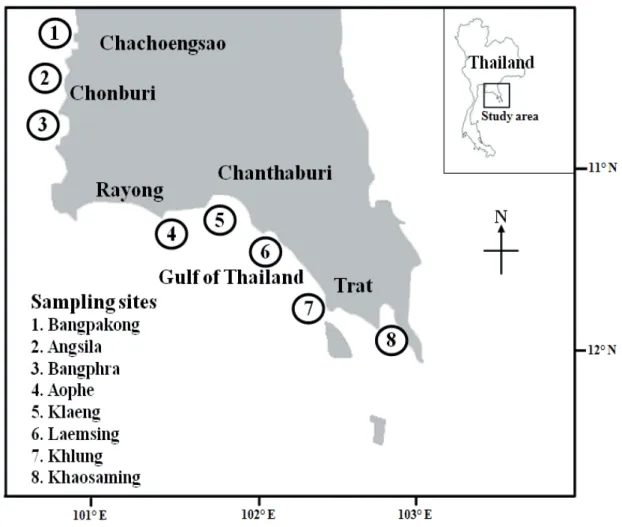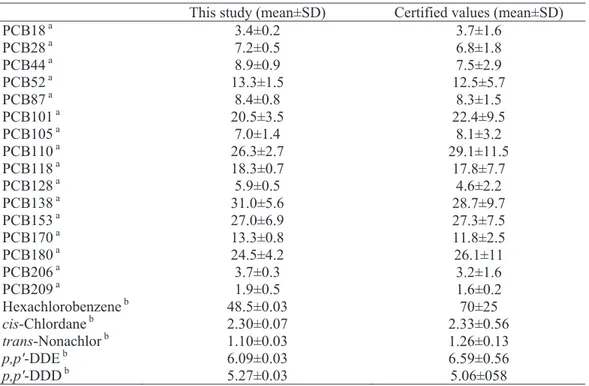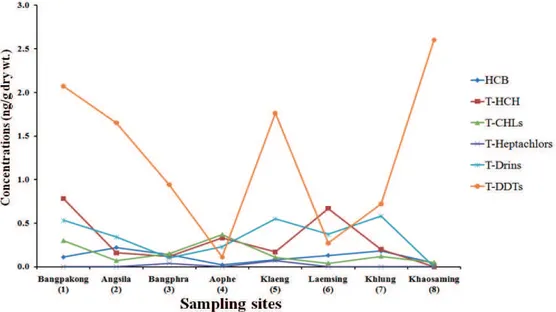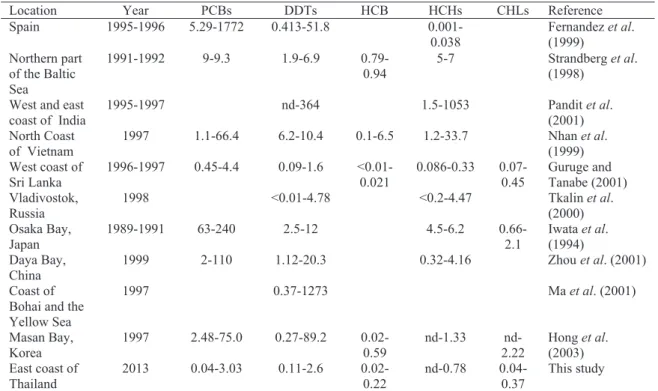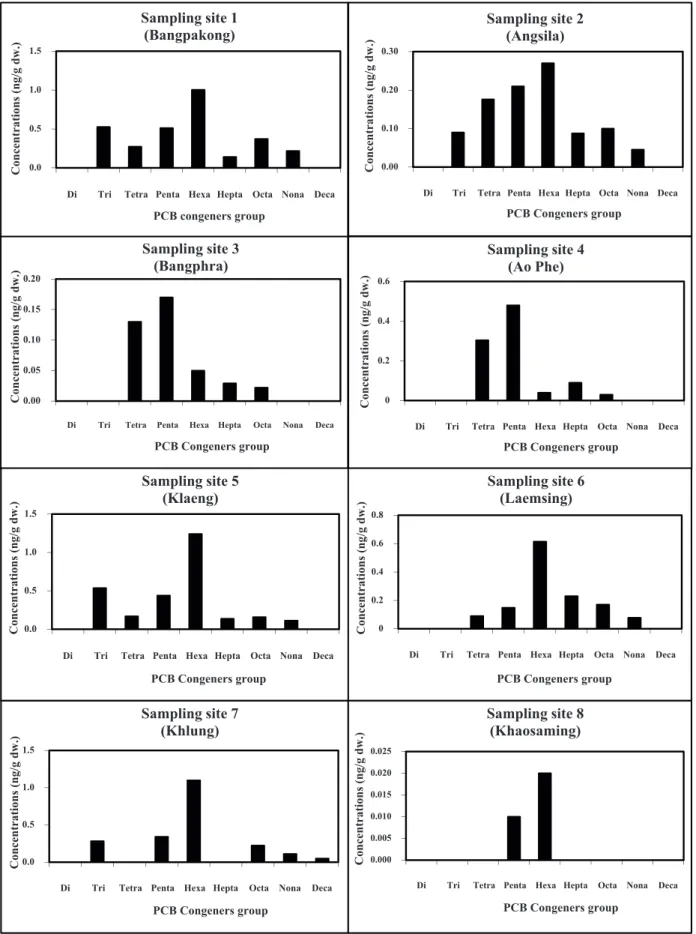Organochlorine pesticides (OCs) and PCBs concentration were analyzed in sediments from east coast of Thailand. The samples were collected in April 2013 and were analyzed by GC/ECD. Organochlorine pesticide concentrations were detected in sediments in the range of 1.06–3.71 ng/g calculated on dry weight basis. T-DDTs concentrations were the highest in OCs group compared to other groups in most of the samples. PCBs concentrations were detected in sediments in the range of 0.04–3.03 ng/g calculated on dry weight basis. This study suggests that there is no correlation between the results of different stations but proximity to the sources of contamination may be the most important determining factor for the dominance of these contaminants. Probably this contamination seems to be localized due to the presence of urban
runoff, municipal sewage, industrial waste, outlow from agricultural area and chemical spill.
Keywords: organochlorine pesticides; PCBs; sediment
1. Introduction
Organochlorines such as PCBs (Polychorinated biphenyls), DDTs (Dichloro Diphenyl Trichloroethanes), HCHs (Hexachlorocyclohexane), CHLs (Chlodane related compounds), and HCB (Hexachlorobenzene) etc. were widespread organic compounds which is ubiquitous in the environment. Owing to their stable physiochemical properties, once they come in to the environment they remain for a long time. Actually these compounds were restricted at many of countries in 1970s, but they have been detected almost of compartments including air, water, biota and sediment until now (Hong et al., 2001). In the aquatic environment, organochlorine compounds are removed from the water column and adsorbed on the particulate matters due to their high afinity for organic matter, and inally accumulated in sediments, which may play a role as secondary contamination source. These contaminants also accumulate in the sediment-dwelling organisms which maybe transferred to higher tropic levels through the food chain (Lee et at., 2001). Sediment is a useful tool to monitor the surroundings, through which we can identify pollution status for recent several years. (Hong et al., 2001).
2. Materials and Methods
2.1. Sample collection
Sediments were collected in summer season (April 2013) from east coast of Thailand from 8 sampling sites (Fig. 1). Samples were collected from the ield. Sediment samples stored in pre-combusted and hexane-rinsed amber glass jar. In most of the sampling sites, several samples were collected and pooled in order to obtain a more representative sample of the area. All the samples were kept in a cooler box with ice and transported to the laboratory where they were stored deep frozen. Frozen sediments were thawed and scraped clean and re-frozen at -20ºC before analysis.
2.2. Samples analysis
16 hr. Sulfur was removed by activated Cu. Dry weight was determined 2 g of an each sample. The solvent was evaporated to about 2-3 ml on a water bath. The extract was cleaned up by liquid chromatography using silica gel/alumina column. The column was illed with 10 g of alumina and 20 g of silica gel (deactivated with about 1% and 5% water, respectively), and eluted with 200 ml of dichloromethane. The extract was separated with a high performance liquid chromatography (HPLC; 250 x 22.5 mm I.D. of size-exclusion column) using dichloromethane for further clean-up and fractionation. Collection time of OCs fraction was determined based on retention times of dibromooctaluorobihenyl and perlyene in HPLC calibration solution using an UV detector. When the retention time of both compounds stabilized, the sample was loaded into a HPLC, and OCs fraction was collected. The fraction was concentrated and re-constituted with hexane. The
sample was concentrated with a gentle stream of N2 to
0.5 ml, and 10 ng of internal standard (tetrachloro-m- xylene) was added.
A Hewlett-Packard 5890 gas chromatograph (GC) with an electron capture detector was used for identiication and quantiication of OCs in samples. The column used for analyses was fused silica capillary DB-5 (30 m x 0.25mm i.d. x 0.25 μm thickness). Helium gas was used as the carrier gas and argon: methane (95:5) used as the make-up gas. The GC temperature was programmed as follows; 100C (1 min holding time), heated to 140ºC at a rate of 5ºC/min (1 min holding time) and heated to 300ºC at a rate of 10ºC/min (5 min holding time). The extracts were concentrated in a steam bath with a three-ball Snyder column. The extracts then were cleaned up by: (1) silica gel and alumina column chromatograpy, and (2) High-Performance Liquid Chromatography (HPLC). The final extracts were
Jakkapan Potipat et al. / EnvironmentAsia 7(1) (2014) 126-133
Figure 1. The sampling sites along the east coast of Thailand
P
of the certiied value for almost of the target OCs (Table 1).
3. Results and Discussion
3.1. Organochloride residues concentration
The concentrations of organochorine residues (OCs) detected in sediment is given in Fig. 3. Higher values of OCs concentration are observed at sampling site 1 where the sampling site 1 is located near the developing industrial facilities. The city also has
one of major factor for inluencing distribution of the concentration of organochlorine pesticides. The usage of DDT for agricultural purposes has been banned in Thailand since 1983, but still being used for malaria vector control (Ruangwises et al., 1994).
Although monitoring data on CHL residues in sediments are scarce even on an international basis, comparable levels were found in Thailand with Asian countries such as Sri Lanka, Japan and Korea. Total CHLs-concentrations (Sum of α-Chlordane, γ-Chlordane, cis-nonachlor and trans-nonachlor) were
Table 1. The results of certified reference material (EC-4 and SRM 1941a) analysis (n=10) in comparison with the certified values (ng/g dry wt.)
This study (mean±SD) Certified values (mean±SD) PCB18 a
PCB28 a PCB44 a PCB52 a PCB87 a PCB101 a PCB105 a PCB110 a PCB118 a PCB128 a PCB138 a PCB153 a PCB170 a PCB180 a PCB206 a PCB209 a
Hexachlorobenzene b
cis-Chlordane b
trans-Nonachlor b
p,p'-DDE b
p,p'-DDD b
3.4±0.2 7.2±0.5 8.9±0.9 13.3±1.5
8.4±0.8 20.5±3.5
7.0±1.4 26.3±2.7 18.3±0.7 5.9±0.5 31.0±5.6 27.0±6.9 13.3±0.8 24.5±4.2 3.7±0.3 1.9±0.5 48.5±0.03 2.30±0.07 1.10±0.03 6.09±0.03 5.27±0.03
3.7±1.6 6.8±1.8 7.5±2.9 12.5±5.7
8.3±1.5 22.4±9.5
8.1±3.2 29.1±11.5
17.8±7.7 4.6±2.2 28.7±9.7 27.3±7.5 11.8±2.5 26.1±11 3.2±1.6 1.6±0.2 70±25 2.33±0.56 1.26±0.13 6.59±0.56 5.06±058
a
EC-4; A Toronto harbor sediment for toxic organics produced by National Water Research Institute, Environment Canada.
b
detected in every stations, ranging from 0.04-0.37 ng/g while earlier study by Guruge and Tanabe (2001) showed a range of 0.07-0.45 ng/g, Iwata et al. (1994) showed a range of 0.66-2.1 ng/g and Hong et al. (2003) showed a range of nd-2.22 ng/g.
Total HCH-concentrations (ΣHCH; sum of α-, β-, and γ-HCH) in sediments are in the range of nd-0.78 ng/g (Table 2 ). Concentrations of HCHs were rela-tively low in comparison to overseas data. The usage of technical-grade HCH and lindane (puriied -HCH), which has been used as broad spectrum insecticide for fruit, grain and seed, has been banned and/or has been restricted in many countries (including Thailand) since 1970s. However, lindane is still used in several
countries, including Canada and US, as seed dressing and a medical purpose reagent (Willett et al., 1998). The application of γ-HCH (lindane) still appears to be continuing in Thailand (Siriwong et al., 1991). The detection of γ-HCH as a prevalent isomer in some locations may suggest the usage of lindane in Thailand (Ruangwises et al., 1994; Kannan et al., 1995). However, the quantity of HCH usage in Thailand seems to be quite small, because of its reside levels in the present study were lower than in other Asian countries such as Vietnam and India (Table 2). Between 1948 and 1997 total global usage of technical HCH was estimated to be approximately 10 million tons (Li, 1999).
Figure 2. Chromatogram of organochlorine pesticide and PCBstandards
Į Ȗ
Figure 3. Organochlorine pesticide concentrations (ng/g dry wt.) in sediment from the east coast of Thailand
Ȉ Į ȕ Ȗ
J
J
Japan 2.1 (1994) Daya Bay,
China
1999 2-110 1.12-20.3 0.32-4.16 Zhou et al. (2001)
Coast of Bohai and the Yellow Sea
1997 0.37-1273 Ma et al. (2001)
Masan Bay, Korea
1997 2.48-75.0 0.27-89.2
0.02-0.59
nd-1.33
nd-2.22
Hong et al. (2003) East coast of
Thailand
2013 0.04-3.03 0.11-2.6
0.02-0.22
nd-0.78 0.04-0.37
This study
nd = not detectable
¦
Figure 5. The PCB congeners group in sedment from the east coast of Thailand
0.0 0.5 1.0 1.5
Di Tri Tetra Penta Hexa Hepta Octa Nona Deca
C o n ce n tra ti o n s (ng /g d w .)
PCB Congeners group Sampling site 7
(Khlung) 0.000 0.005 0.010 0.015 0.020 0.025
Di Tri Tetra Penta Hexa Hepta Octa Nona Deca
C o n ce n tra ti o n s (ng /g d w .)
PCB Congeners group Sampling site 8
(Khaosaming) 0.00 0.05 0.10 0.15 0.20
Di Tri Tetra Penta Hexa Hepta Octa Nona Deca
C o n ce n tra ti o n s (ng /g d w .)
PCB Congeners group Sampling site 3
(Bangphra)
0 0.2 0.4 0.6
Di Tri Tetra Penta Hexa Hepta Octa Nona Deca
C o n ce n tra ti o n s (ng /g d w .)
PCB Congeners group Sampling site 4
(Ao Phe)
0.0 0.5 1.0 1.5
Di Tri Tetra Penta Hexa Hepta Octa Nona Deca
C o n ce n tra ti o n s (ng /g d w .)
PCB Congeners group Sampling site 5
(Klaeng) 0 0.2 0.4 0.6 0.8
Di Tri Tetra Penta Hexa Hepta Octa Nona Deca
C o n ce n tra ti o n s (ng /g d w .)
PCB Congeners group Sampling site 6
(Laemsing) 0.0
0.5 1.0 1.5
Di Tri Tetra Penta Hexa Hepta Octa Nona Deca
C o n ce n tra ti o n s (ng /g d w .)
PCB congeners group Sampling site 1
(Bangpakong)
0.00 0.10 0.20 0.30
Di Tri Tetra Penta Hexa Hepta Octa Nona Deca
C o n ce n tra ti o n s (ng /g d w .)
PCB Congeners group Sampling site 2
The spatial differences in organochlorine residue levels in sediments collected from the east coastal waters of Thailand suggested that these compounds were widely used in Thailand. Although the agricultural usage of organochloride pesticides, such as DDT and HCH, was banned in Thailand, their current sources still remain in the aquatic environment. When compared to the international data, residue levels of organochlorine pesticides in Thailand’s marine environment was lower. Considering the data on an international basis (Table 2), contamination by organochlorine pesticides is not of serious concern. Distribution of OC and PCB concentrations (ng/g dry wt.) in sediment from the east coast of Thailand are given in Fig. 4.
3.2. PCB concentrations
Total PCB concentrations (PCB; sum of 22 congeners) from 8 sediment samples range from 0.04–3.03 ng/g dry wt. Concentrations of PCBs in this study were generally very low (Table 2). Concentrations of PCB in sediments from the east coast of Thailand exhibited a smaller variation among locations. An earlier study in Sri Lanka by Guruge and Tanabe (2001) also give the similar results with a range of 0.45-4.4 ng/g and much lower than in more industrialized countries such as Japan, China and Korea. The higher concentrations, with a maximum at station 1 (3.03 ng/g), could be due to the waste drainage from the industrialized city and the power plant. The possible sources may be from transformer luids and hydraulic additives. One of the major source of PCBs in Thailand is considered to be transformers and capacitors imported by Electricity Authority of Thailand (Watanabe et al., 1996). Watanabe et al. (1996) recorded the PCB pollution in the dumping site of transformers and capacitors located at suburb Bangkok near by the estuary of Chao Phraya river. Although the studies suggests the contamination by
less than those of developed nations. This could be explained by the lux modeling study in the tropics, which suggest that OCs budget to the aquatic ecosystem was less signiicant and its residence time was quite short, whereas transfer to the atmosphere was much larger due to the high temperature (Watanabe et al., 1996). Concentrations of DDTs and PCBs in sediment in this study were the highest among all of the chlorinated hydrocarbons detected here. The results were shown a smaller variation and not of serious concern. Most of these PCB pollutions in Thailand are probably from the transformers and capacitors. The major parameters that determine the PCB concentration levels are likely to be the distance from the factory district, characteristics of the sediment, and transportability of the sediment by the lowing of river water (Jeong et al., 2001).
Reference
Falandysz J, Strandberg B, Strandberg L, Bergqvist P, Rappe C. Concentrations and spatial distribution of chlordanes and some other cyclodiene pesticides in Baltic plankton. The Science of the Total Environment 1998; 215(3-4): 253-58.
Fernandez MA, Alonso C, Gonzales MJ, Hernandez LM. Occurrence of organochlorine insecticides, PCBs and PCB congeners in waters and sediments of the Ebro River (Spain). Chemosphere 1999; 38(1): 33-43. Guruge KS, Tanabe S. Contamination by persistent
organochlorines and butyltin compounds in the west coast of Sri Lanka. Marine Pollution Bulletin 2001; 42: 179-86.
Hong SH, Yim UH, Shim WJ, Oh JR, Lee IS. Horizontal and vertical distribution of PCBs and chlorinated pesticides in sediments from Masan Bay, Korea. Marine Pollution Bulletin 2003; 46(2): 244-53.
Iwata H, Tanabe S, Sakai N, Nishimura A, Tatsukawa R. Geographical distribution of persistent organochlorines in air, water and sediments from Asia and Oceania, and their implications for global redistribution from lower latitudes. Environmental Pollution 1994; 85(1): 15-33.
Jeong GH, Kim HJ, Joo YJ, Kim YB, So HY. (2001). Distribution characteris tics of PCBs in the sediments of the lower Nakdong River, Korea. Chemosphere 2001; 44(6): 1403-11.
Kannan K, Tanabe S, Tatsukawa R. (1995) Geographical d i s t r i b u t i o n a n d a c c u m u l a t i o n f e a t u r e s o f
organochlorine residues in ish in tropical Asia and
Ocenian. Environmental Science and Technology 1995; 29: 2673-83.
Kennisch MJ. Practical handbook of estuarine and marine pollution. Boca Raton, CRC Press, Marine Science Series, NY, USA. 1996.
Lee KT, Tanabe S, Koh CH. (2001) Distribution of organochlorine pesticides in sediments from Kyeonggi bay and nearby areas, Korea. Environmental Pollution 2001; 114(2): 207-13.
Li S. Pesticides, environmental pollution and human health in China. In: Chemistry, agriculture and the environment (Eds: Richardson ML). The Royal Society of Chemistry, UK. 1991; 389-409.
Ma M, Feng Z, Guan C, Ma Y, Xu H, Li H. DDT, PAH and PCB in sediments from the intertidal zone of the Bohai Sea and the Yellow Sea. Marine Pollution Bulletin 2001; 42(2): 132-36.
Nhan DD, Am NM, Carvalho FP, Villeneuve JP, Cattini C. Organochlorine pesticides and PCBs along the coast of north Vietnam. Science of the Total Environment 1999; (237-238): 363-71.
Pandit GG, Mohan Rao AM, Jha SK, Krishnamoorthy TM, Kale SP, Raghu K, Murthy NBK. Monitoring of organochlorine pesticide residues in the Indian marine environment. Chemosphere 2001; 44(2): 301-05. Ruangwises S, Ruangwises N, Tabucanon MS. Persistent
organochlorine pesticides residues in green mussels (Perna viridis) from the gulf of Thailand. Marine Pollution Bulletin 1994; 28(6): 351-55.
Siriwong C, Hironaka H, Onodera S, Tabucanon MS. Organochlorine pesticides residues in green mussel (Perna viridis) from the gulf of Thailand. Marine Pollution Bulletin 1991; 22(10): 510-16.
Strandberg BO, Bavel BV, Bergqvist P-A, Broman D, Ishaq R, Naf C, Pettersen H, Rappe C. Occurrence, sedimentation and spatial variations of organochlorine contaminants in settling particulate matter and sediment in the northern part of the Baltic Sea. Environmental Science Technology 1998; 32: 1754-59.
Tanabe S, Tatsukawa R. Chemical modernization and vulnerability of Cetaceans: increasing toxic threat of organochlorine contaminants. In: Persistent Pollutants in Marine Ecosystems (Eds:Walker CH, Livingstone DR). Pergamon Press, Oxford, UK. 1992; 161-77.
Tkalin AV, Samsonov DP, Lishavskaya TS, Ghernik GV. (2000). New data on organochlorine distributions in the marine environment near Vladivostok. Marine Pollution Bulletin 2000; 40: 879-81.
Watanabe S, Laovakul W, Boonyathumanondh R, Tabucanon MS, Ohgaki S. Concentrations and composition of PCB congeners in the air around stored used capacitors containing PCB insulator oil in a suburb of Bangkok, Thailand. Environmental pollution 1996; 92(3): 289- 97.
Willett KL, Randerath K, Zhou GD, Safe SH. (1998). Inhibition of CYPIAI-dependent activity by the
polynuclear aromatic hydrocarbon (PAH) luoranthene.
Biochemical Pharmacology 1998; 55(6): 831-39. Zhou JL, Maskaoui K, Qiu YW, Hong HS, Wang ZD. (2001).
Polychlorinated biphenyl congeners and organochlorine insecticides in the water column and sediments of Daya Bay, China. Environmental Pollution 2001; 113(3): 373-84.
Received 15 October 2013 Accepted 10 December 2013
Correspondence to Jakkapan Potipat
Department of Environmental Science, Faculty of Science and Technology, Rambhai Barni Rajabhat University, Chanthaburi, 22000
Thailand
Tel: +668 3068 0800 Fax: +66 3947 1060
